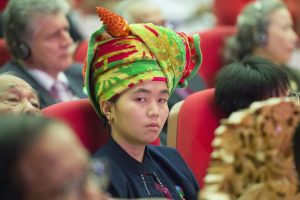In a New Year’s address to the nation on January 1, Myanmar’s State Counselor Aung San Suu Kyi promised to take a new approach to long-delayed peace negotiations aimed at ending the country’s tangled web of civil conflicts.
According to a report in The Irrawaddy, Aung San Suu Kyi, whose second five-year term begins in March, announced plans for a “New Peace Architecture,” which would welcome participation by political groups, civil society organizations, and the public.
She said that the aim was to broaden the scope of who had a say in the ongoing talks, with the hope of consolidating inter-ethnic trust and inducing more ethnic armed groups to join the Nationwide Ceasefire Agreement (NCA) in time for the 75th anniversary of Myanmar’s independence in January 2023.
“We recognize the important role of public participation [in the peace process],” Myanmar’s leader said, according to The Irrawaddy. “This depends on how much we can pave the way for all stakeholders to participate.”
The NCA was signed in late 2015 between the Myanmar government and eight ethnic rebel organizations, while two more joined in February 2018. But the peace process continues to exclude some of the country’s largest and most prominent armed rebel groups, and since the signing of the NCA, fighting with some of them has reached levels not seen in years.
To be sure, recent months have seen encouraging progress in efforts to resolve the conflict between the military and the insurgent Arakan Army (AA) in western Myanmar. Shortly after national elections on November 8 that returned a lopsided victory for Aung San Suu Kyi’s National League for Democracy (NLD), the two sides declared an informal ceasefire after two years of fighting that killed and injured hundreds and forced some 226,000 people from their homes. On January 1, the AA released three former NLD candidates it abducted in October, and returned three captured soldiers to the Tatmadaw, and there is now the possibility that elections may be held in conflict areas after their cancellation ahead of the November poll.
But given the sheer number and complexity of Myanmar’s various ethnic conflicts, and the accretions of mistrust that have built up since independence in 1948, substantial progress will not be easy to produce or sustain. The challenge was illustrated in a small but telling way by an incident in Karen State’s Ayeyarwaddy Region on January 3, in which local authorities forced ethnic Karen villagers to remove a statue of Karen nationalist leader Saw Ba U Gyi.
The statue was erected in August 2020, after which the local population claims it faced consistent pressure from the government and military officials to remove it. According to the Karen Human Rights Group (KHRG), which reported the removal of the statue, the villagers eventually complied, fearing legal action.
The statue’s removal came after earlier instances in which the Myanmar military, or Tatmadaw, objected to the installation of statues of Saw Ba U Gyi, who led the earliest incarnation of the Karen National Union (KNU) before he was killed in an ambush by the Tatmadaw in 1950, and remains a totemic figure for many Karen people. KHRG claimed that such incidents have “created a feeling of injustice among local Karen villagers and undermined their trust in the peace process, which is based on the promise of equality between ethnic groups.”
KHRG also described the local discontent at the erection of statues of the independence leader Aung San in ethnic minority states, which have at times prompted protests. In February 2019, for instance, the police used violent force to break up a demonstration against the installation of a statue of Aung San in Kayah State.
Before his assassination in 1947, Aung San helped win Myanmar’s independence from Britain and presided over the Panglong Agreement, which accepted the principle of “full autonomy in internal administration” for what the British then termed “frontier areas.” But the agreement was never fully implemented, and Aung San’s central role in the founding of the Tatmadaw, which subsequently prosecuted grinding wars against ethnic minority peoples seeking independence or autonomy, has complicated his legacy outside Myanmar’s ethnic Burman heartland.
As KHRG argues, the Tatmadaw and central government have “been consistently banning Karen communities from paying tribute to their historical figures, while forcefully imposing symbols related to Burmese culture and history in ethnic areas.”
The presence of such granular prejudices and resentments suggests that despite Aung Suu Kyi’s promises to inject more voices into the process of negotiating peace, a comprehensive resolution to Myanmar’s welter of civil conflicts remains a distant prospect.

































